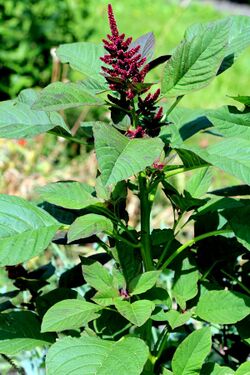Biology:Amaranthus hypochondriacus
| Amaranthus hypochondriacus | |
|---|---|

| |
| Scientific classification | |
| Kingdom: | Plantae |
| Clade: | Tracheophytes |
| Clade: | Angiosperms |
| Clade: | Eudicots |
| Order: | Caryophyllales |
| Family: | Amaranthaceae |
| Genus: | Amaranthus |
| Species: | A. hypochondriacus
|
| Binomial name | |
| Amaranthus hypochondriacus | |
| Synonyms[2] | |
|
List
| |
Amaranthus hypochondriacus is an ornamental plant commonly known as Prince-of-Wales feather[3] or prince's-feather.[4][5] Originally endemic to Mexico, it is called quelite, bledo[6] and quintonil in Spanish.[7][8]
In Africa and El Salvador, like many other species in the family Amaranthaceae, it is valued as source of food.[9] The leaves and seeds are very nutritious and have a mild flavor.[10] The seeds also contain phenolic compounds.[11]
In temperate regions, it is cultivated as a half-hardy annual. Numerous cultivars have been selected, of which 'Green Thumb'[12] and 'Pygmy Torch'[13] have gained the Royal Horticultural Society's Award of Garden Merit. It grows best in well-drained soils in full sun, and is suitable for USDA hardiness zones 3–10. It may be susceptible to aphids.[14]
A. hypochondriacus is a vigorous, upright plant that typically reaches 40–200 cm (15–80 in) tall.[10] It is often grown for its flowers, which appear in dense, catkin-like inflorescences in the summer and autumn. They are usually deep purplish-red, but may be yellow-green.[14] These give way to dry fruits, about 1.5–3 mm (1⁄16–1⁄8 in) long, that split open when ripe.[15] The fruits contain smooth, shiny seeds that may be subglobose to lenticular, either whitish-pink or dark reddish-brown to black, and 1–1.4 mm (3⁄64–1⁄16 inch) in diameter.[16] The leaves are simple and alternately arranged, with entire margins.[15] They are rhombic-ovate to broadly lanceolate in shape, about 4–12 cm (1 1⁄2–4 1⁄2 inches) long and 2–7 cm (1–3 inches) wide, borne on long peduncles.[16]
References
- ↑ "NatureServe Explorer". https://explorer.natureserve.org/Taxon/ELEMENT_GLOBAL.2.128128/Amaranthus_hypochondriacus.
- ↑ "The Plant List: A Working List of All Plant Species". http://www.theplantlist.org/tpl/record/kew-2632908.
- ↑ "Amaranthus hypochondriacus". Natural Resources Conservation Service PLANTS Database. USDA. https://plants.usda.gov/core/profile?symbol=AMHY2. Retrieved 7 January 2016.
- ↑ (xls) BSBI List 2007, Botanical Society of Britain and Ireland, https://bsbi.org/download/3542/, retrieved 2014-10-17
- ↑ Phillips, Edward (1720). The New World of Words. 7th ed.
- ↑ "Cultivos andinos: Introducción". FAO: Oficina Regional de para América Latina y el Caribe. http://www.rlc.fao.org/es/agricultura/produ/cdrom/contenido/libro11/cap4.htm. Retrieved 2011-02-04.
- ↑ "Semillas de Amaranto". UNAM: Colección Etnobotánica. http://www.ibiologia.unam.mx/herbario/galerias/colecciones_asociadas/pages/Semillas_amaranto.html. Retrieved 2011-02-04.
- ↑ "El amaranto". University of Guadalajara: Centro Universitario de Biológicas y Afropecuarias. http://www.cucba.udg.mx/sitiosinteres/coaxican/plts_mex/amaranto/amaranto.htm. Retrieved 2011-02-04.
- ↑ Grubben, G.J.H. & Denton, O.A. (2004) Plant Resources of Tropical Africa 2. Vegetables. PROTA Foundation, Wageningen; Backhuys, Leiden; CTA, Wageningen.
- ↑ 10.0 10.1 "Amaranthus hypochondriacus - Useful Tropical Plants". http://tropical.theferns.info/viewtropical.php?id=Amaranthus+hypochondriacus.
- ↑ Barba de la Rosa, A.P.; Fomsgaard, Inge S.; Laursen, Bente; Mortensen, Anne G.; Olvera-Martínez, L.; Silva-Sánchez, C.; Mendoza-Herrera, A.; González-Castañeda, J. et al. (2009-01-01). "Amaranth (Amaranthus hypochondriacus) as an alternative crop for sustainable food production: Phenolic acids and flavonoids with potential impact on its nutraceutical quality" (in en). Journal of Cereal Science 49 (1): 117–121. doi:10.1016/j.jcs.2008.07.012. ISSN 0733-5210. https://www.sciencedirect.com/science/article/abs/pii/S0733521008001355.
- ↑ "Amaranthus hypochondriacus 'Green Thumb'". RHS. https://www.rhs.org.uk/Plants/106045/Amaranthus-hypochondriacus-Green-Thumb/Details. Retrieved 19 March 2020.
- ↑ "Amaranthus hypochondriacus 'Pygmy Torch'". RHS. https://www.rhs.org.uk/Plants/106046/Amaranthus-hypochondriacus-Pygmy-Torch/Details. Retrieved 19 March 2020.
- ↑ 14.0 14.1 "Amaranthus hypochondriacus (Cocks Comb, Lady Bleeding, Love Lies Bleeding, Pile Wort, Prince-of-Wales Feather, Prince's Feather, Prince's-feather, Red Cocks Comb) | North Carolina Extension Gardener Plant Toolbox". https://plants.ces.ncsu.edu/plants/amaranthus-hypochondriacus/.
- ↑ 15.0 15.1 "Amaranthus hypochondriacus (prince's-feather amaranth): Go Botany". https://gobotany.nativeplanttrust.org/species/amaranthus/hypochondriacus/.
- ↑ 16.0 16.1 "Amaranthus hypochondriacus in Flora of North America @ efloras.org". http://www.efloras.org/florataxon.aspx?flora_id=1&taxon_id=200006983.
- Pink, Alfred (2004). Gardening for the Million.. Project Gutenberg Literary Archive Foundation. https://www.gutenberg.org/ebooks/11892.
External links
| Wikimedia Commons has media related to Amaranthus hypochondriacus. |
- Carl von Linnés digitala växtbibliotek
- PROTAbase on Amaranthus hypochondriacus
- "Amaranthus hypochondriacus". http://www.pfaf.org/user/Plant.aspx?LatinName=Amaranthus+hypochondriacus.
Wikidata ☰ Q159611 entry
 |



